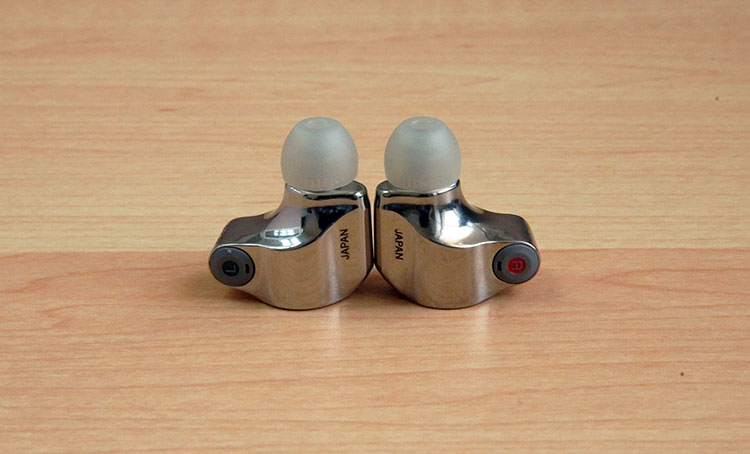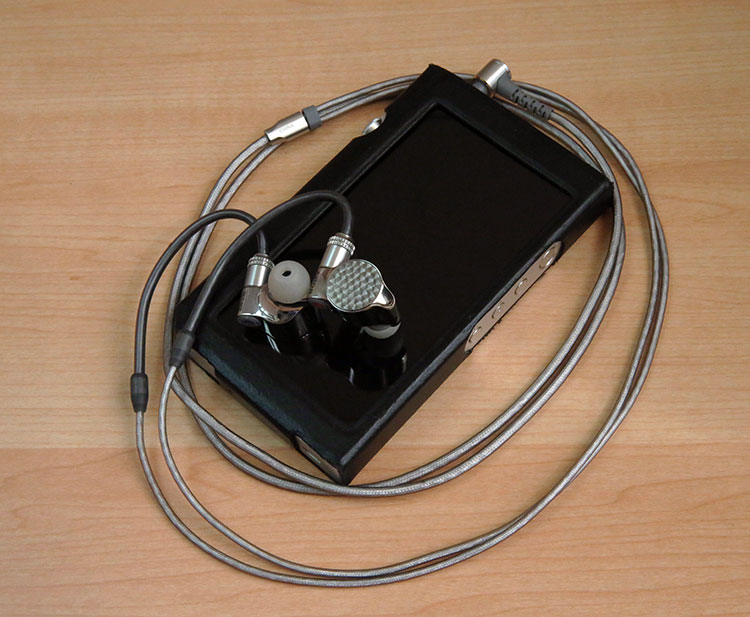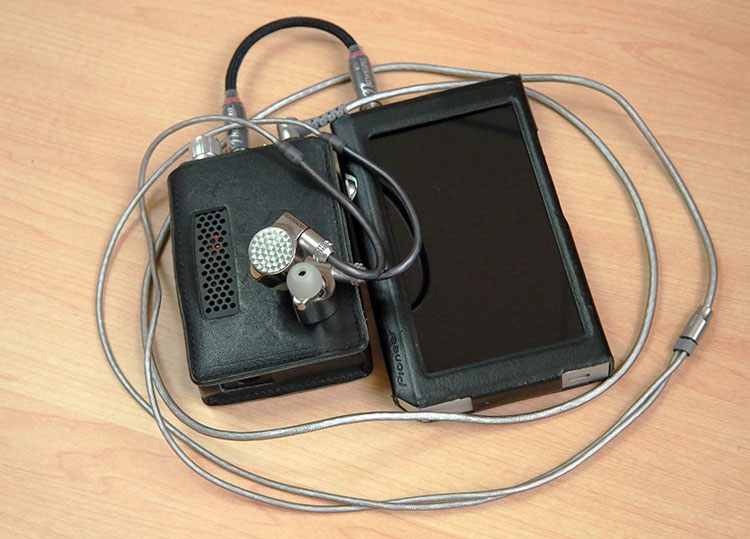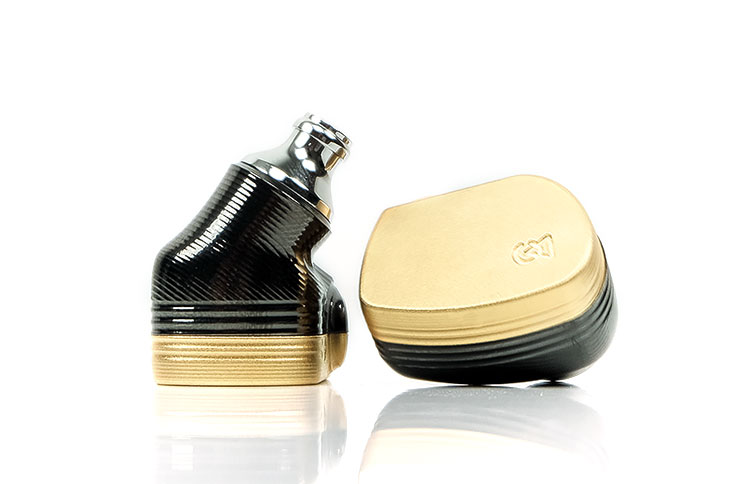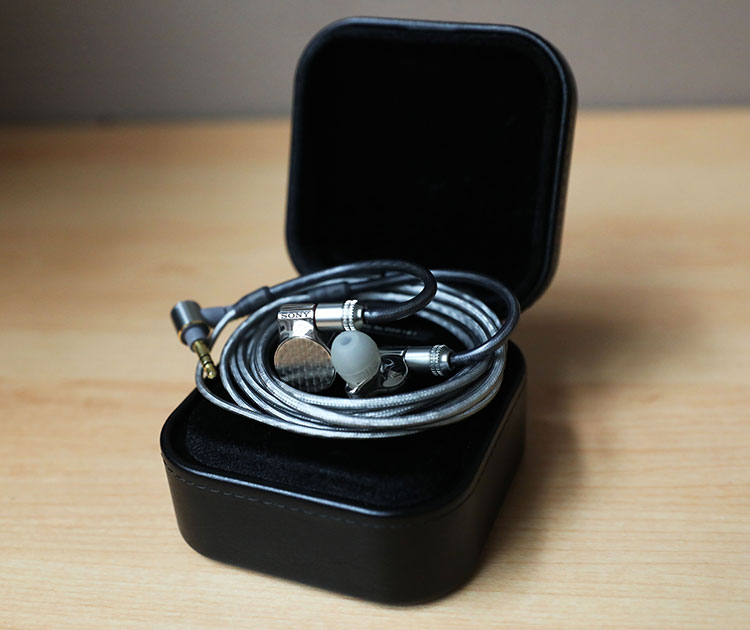Sound Impressions
Pre-Burn-in
Out of the box, the IER-Z1R had a warm and smooth sound signature emphasized by an excellent bass extension and a full-bodied overall presentation. There’s a satisfying rumble in the low end characterized by a mildly loose bass as a result of a slightly slow decay.
While the bass sustain is a bit extended, complex passages maintain top-notch detail and bass texture on fast-paced EDM, Pop, and Rock tracks are still very enjoyable.
Notes in the midrange are thick with a tinge of euphonic timbre due to a tinge of coloration at around 100 to 300 Hz. This gives instruments on the lower octaves some added clarity to compensate for the somewhat rounded bass response.
Highs, meanwhile, are quite laidback with the dip starting at 4 kHz thus, giving a fatigue-free listening experience that is void of any harsh peaks.
Even with the relaxed treble presentation, IER-Z1R manages to belt out an excellent level of micro detail but I found myself yearning for some added attack as I personally would like a little bite on snares and other percussions.
Staging on the IER-Z1R prior to the burn-in is still great with the width and height extending out of the head while also portraying great depth and layering. Z1R has surprisingly large headroom despite the lack of treble extension while instrument separation is top-notch as well.
As for imaging, the accuracy is impeccable as instruments each have a distinct space in the soundstage.
Post-Burn-in
I have put over 150 hours of burn-in time on the IER-Z1R and I’d say the overall sound has made improvements in almost all aspects. The soundstage has become more expansive and there’s quite a noticeable difference in its tonality.
Staging
The IER-Z1R boasts a very expansive soundstage even out of the box and I didn’t really think the burn in would do so much. However, I found that there is some added height and just a little bit of width.
There’s also some improvement in instrument separation now that the burn-in has resulted in some added air due to a more extended treble.
Depth remains virtually the same and its staging provides a fairly out-of-your-head experience with an enjoyable 3D feel to it. Overall, I’d say this is one of the best instrument separation and layering that I’ve heard from a hybrid driver set up.
Tonality
From a warm and smooth tonality, the IER-Z1R now has a balanced sound with a mild U-shaped signature. The Bass has now become tighter and deeper while the warmth has become less prominent.
There is still a tinge of warmth yet not as warm out of the box. Mids have been pushed back quite a bit particularly in its lower registers but it is not excessively recessed.
The treble, for its part, now boasts excellent extension adding clarity and air to the overall presentation. The overall timbre of IER-Z1R keeps everything fairly natural even with the boost in its bass and treble.
he Refined-phase Structure also proved to be handy for its overall sound since it is void of any incoherence while Sound Space Control technology has managed to contribute to the big soundstage as well as the organic timbre.
Bass
The IER-Z1R has an elevated bass response with the boost becoming more apparent in the sub-bass region at around 50 Hz which is sustained until around 150 Hz before gradually dipping.
The drop past 150 Hz is not drastic and uneven so, despite the apparent sub-bass bias, the low-end maintains a fairly balanced presentation with an organic timbre.
Decay, meanwhile, is relatively pacey allowing uptempo music to shine without losing any detail. One thing I find noteworthy is how good the bass texture is on the IER-Z1R.
You could definitely hear the separation of the bass guitar and the kick drums even on intricate tracks. While there is an obvious boost in the low-end, its rumble and punch are well-controlled without sounding boomy.
Examples
Basically Saturday Night’s “El Poder” has become my go-to test track for bass response and Z1R is able to render the fast and complex bass line with great resolution and detail.
Dua Lipa’s Lost in your Light also has this fast-paced oscillation in its bass line as well as a punchy bass drum and both are presented nicely by the Z1R without going overboard in its slam and avoiding any apparent loss in detail.
The bass from Daft Punk’s Get Lucky was rendered smoothly as well with each note boasting good impact.
Mids
The dip starting in the midbass is sustained through the lower midrange of the Z1R. There’s a slight roll-off starting at around 200 Hz with the trough pegged at around 600 Hz before gradually climbing to a neutral tone just beyond 1 kHz.
There is then a steady boost heading towards 2 kHz before resetting to a flat response right around 4 kHz. Despite the mildly recessed lower mids, there is a smooth transition in the frequencies thus avoiding any odd and unnatural harmonics.
With the upper midrange bias, stringed instruments, as well as vocals on higher octaves, get more emphasis. The lower midrange, however, is neither overly recessed nor thin-sounding due to the power from the boosted sub-bass region.
Mids Clarity
While there is top-notch clarity and a fairly transparent midrange, its lower registers lack the presence which in turn takes away just a little of body and weight on snares and other percussions. Nonetheless, the midrange of Z1R remains transparent and open-sounding while providing a good level of attack.
The focus on the upper midrange of the Z1R was more prominent when I took it for a spin on Alice in Chains’ track “Brother” from their MTV Unplugged album.
The track portrays a well-layered vocal presentation from both Layne Staley and Jerry Cantrell. While Z1R is able to achieve superb separation on the vocals, the upper midrange spike provides more clarity and presence on Staley’s high-pitched voice compared to the low-pitched voice of Cantrell which is pushed back just a little bit.
Listening to the acoustic guitars from the same track, high notes on the chords are more highlighted but the low-pitched strings still manage to maintain satisfactory weight and body even with the slight lower-midrange roll-off.
Highs
The presence region gets a flat response starting at 4 kHz before dropping heading towards 6 kHz. From there on, there’s a neutral tuning yet a polite uptick around 8 to 18 kHz comes in to play before fading back to neutral.
Sony claims that their super tweeter is able to produce a treble extension that could reach around 100 kHz. But my hearing could only perceive frequencies up to 18 kHz.
Z1R has a palatable sparkle that manages to keep harshness at bay while there’s also some ample air which contributes to an open sound as well as a huge headroom. The mild boost in the brilliance region provides an added resolution and clarity to the overall presentation and despite the slight lift, there is no tinge of metallic timbre to the sound.
Detail retrieval, meanwhile, is excellent as it is able to produce even the tiniest detail with no effort. Decay is relatively fast which contributes to an organic timbre even with the minor dips and spikes across the treble region.
Testing Coldplay’s Adventure of a Lifetime, the guitar effects and synths were performed with excellent detail and attack. Lynyrd Skynyrd’s Free Bird was a pleasure to listen to on the Z1R as well, especially on the 4-minute guitar solo where you’d get an energetic and lively treble presentation.
Red Hot Chilli Peppers’ Give it Away also had a satiating treble bite with no hint of harshness in its cymbals and high-pitched guitar riffs using the Z1R.
Tip-rolling
As aforementioned, the Z1R comes with two sets of tips namely the silicone hybrid and the memory foam triple comfort. Both are equally comfortable and they both provide an excellent seal. Yet they sound slightly different.
For the hybrids, I found the sound to be balanced and it basically reveals the sound signature of the Z1R. The triple comfort, on the other hand, gives the Z1R a more pronounced midbass for some added warmth and punch while it also tames the treble a bit.
The soundstage was also affected when I switched to the triple comfort as it suffered a bit of decreased width. This decrease in width, however, is negligible as it doesn’t congest the sound. There’s a bit more depth with the triple comfort while height remains as is.
Preferentially, I’d see myself constantly switching between these two for they each still provide good sound as well as an excellent fit.
Synergy
Efficiency and Noise
The Z1R is rated at 40Ω at 104 dB so you’d get the best out of it when it gets some good power source. While I can already enjoy it straight from my Samsung Galaxy S9+, I feel that there’s a bit of a loss of dynamics. Off from my trusty Pioneer XDP-300R, I could get enjoyable listening volumes around 90 to 95 without any detail loss.
Using the 300R and the Alo Audio Continental V5 (CV5), I can get some decent loudness and dynamics at around 3 o’clock on low gain. The CV5 has a high noise floor yet the Z1R manages to remain dead silent. I also had the same settings on the knob using the Ray Samuels Audio SR-71A and the details and dynamics were really impressive.
I also paired it with the Sony WM1A through its 4.4mm balanced port and I found the comfortable listening volume at around 40 on medium gain. The Lotoo Paw Gold Touch through its balanced output effortlessly fed enough power to make the Z1R shine.
Synergy
Smartphones
The pairing with the Samsung Galaxy S9+ was rather a bit lackluster since as I’ve mentioned, there was a bit of loss in details and dynamics. Tonally, it’s quite enjoyable as I could get more bass slam as well as a nice treble bite. The midrange, particularly its lower registers, is still a bit recessed yet it doesn’t sound congested.
Amping
The 300R + CV5 stack was good and it basically revealed the signature of the Z1R. The bass was well-controlled even with the minor boost while its lower midrange was still pushed back quite a bit. What I like about this pairing are the open-sounding midrange and the deep staging.
DAPs
The Z1R was a different beast when I paired it with the Lotoo Paw Gold Touch. The lower mids was pushed forward a bit while the treble had better control, thus creating a more balanced sound.
The stage was wide and spatial cues as well as micro details were rendered with ease. As for the staging, there’s a bit more forwardness to its overall presentation but the width and height was something to be awed about as it reaches far out of your head.
As for the Sony WM1A pairing, its tonality was somehow comparable to that of the Lotoo Paw Gold Touch but the latter simply bests Sony’s DAP in terms of staging, dynamics, and detail retrieval.
The WM1A gave a more balanced sound to the Z1R and it also had a fairly out-of-your-head experience but the staging was not as big as the more expensive Lotoo Paw Gold Touch.
Select Comparisons
Campfire Audio Solaris
Technical
The Solaris employs a quad hybrid driver setup including a 10mm dynamic for the lows and mids, one BA driver for the mids, and dual custom BA drivers.
While Z1R makes use of the tubing system called Sound Space Control technology, Campfire opted for a tubeless system through their tubeless acoustic expansion chamber or T.A.E.C.
As for its build, the Solaris has a 24k gold-plated faceplate with Campfire’s logo engraved on the lower right side along with an alloy body as well as stainless steel nozzle. Just like the Z1R, the Solaris is on the heavier side yet its size is a bit larger compared to Sony’s.
Performance
Rated at 10Ω and 115dB sensitivity, the Solaris is basically easier to drive than the Z1R. Off from the smartphone, the Solaris manages to maintain good dynamics and details.
While the Z1R handles the high noise floors from the CV5 as it was dead silent, the Solaris has an audible hiss. The hiss, however, is negligible once the music starts playing.
Sound-wise, both are at par with each other as they share almost the same balanced signature with a very mild U-shape tuning. Both the Solaris and the Z1R have a sub-bass bias in their low end but the latter provides more slam which results in a deeper staging.
Both also have the same lower midrange dip yet both showcase spacious mids with a smooth transition across the frequencies. The Solaris and Z1R also have an elevated upper mids lower treble. Z1R, however, has more extension thus providing an airier and taller presentation.
Preference
Both the Z1r and Solaris have solid build and durability but I’d give the upper hand on the Z1R in terms of fit. I find the bulge on the bottom side of Solaris to be a bit of cumbersome in the pinna. Both are universal fit so I was expecting the Solaris to have a versatile fit that could cater to various ear shapes and sizes.
In my case, the fit was not flush since the area in my pinna is quite small. And while it doesn’t fit well me, I could only surmise that some users would find the Solaris to be the perfect fit for their ears.
As for the sound, both suit my taste in terms of tonality yet I find the Z1R to have a better technical prowess as it has a better instrument separation, layering, and a wider soundstage. Bass and treble are more extended with the Z1R.
Empire Ears Legend X
Technical
The Legend X utilizes a seen hybrid driver configuration including the dual 9mm dynamic drivers called the Weapon IX for the lows, two BA drivers for the mids, one BA driver for the upper mids, one BA driver for the highs, and another BA driver for the upper treble.
As a counterpart for Z1R’s Sound Space Control technology and Refined-phase Structure, Empire Ears has implemented the 10-way SynX crossover design as well as the anti-resonance compound (A.R.C.) that is intended to address resonance and incoherence.
Acrylic semi-custom fit is the weapon of choice for the Legend X’ build. The universal fit makes use of a black acrylic shell bearing the Empire’s logo on its faceplate.
Of the three hybrid IEMs that are put into the comparison in this review, the Legend X is the lightest. However, there is a trade-off in its weight since the acrylic shell, while still sturdy, is significantly soft compared to the metal build of the Z1R.

Performance
The Legend X is rated 14 Ω at 102 dB sensitivity making it virtually easier to drive even paired with a smartphone.
The Legend X scales well with decent portable amps as it belts out a more engaging sound with excellent dynamics and micro detail retrieval when fed with quality power. While there is an audible hiss on the CV5, it doesn’t get too bothersome once the music gets going.
Empires Ears went for a warm and smooth tuning for the Legend X which is characterized by a slightly rounded low end with excellent impact, a smooth and lush midrange, and a tad relaxed treble.
There is a good amount of depth in the staging while the midrange is. Detail retrieval is still excellent and headroom is still huge even with the slightly laidback treble.
Preference
The IER-Z1R and Legend X are excellent in their own right with the former having a more sturdy build while the latter having a more comfortable fit due to a semi-custom design. However, the Legend X has a custom option so in that respect, it gets an edge over the IER-Z1R in terms of fit.
Sound-wise, the Legend X’ bass has more authority and slam to it but the IER-Z1R has better clarity and air. The lush mids of the Legend X is more palatable to my taste yet the IER-Z1R’s midrange is not a slouch at all.
Staging and layering are excellent on both monitors but I like how the added air from the IER-Z1R emphasizes the imaging of instruments.
Our Verdict
Sony stuck to their guns in developing the dual dynamic driver and the single BA driver setup for the IER-Z1R and I’d say it’s a huge success.
From the packaging alone, I was already in for a treat as it gave me more than just taking out plastics and flipping boxes. Rather, I was treated to an experience like that of opening a jewelry box. I couldn’t overemphasize how Sony is generous in throwing in a lot of extras to their accessories, especially with two sets of tips and cables.
I could use this IEM for hours since there are no sharp edges in its design while its ability to provide a deep comfortable seal adds to a very satisfying fit.
Preferences
Those who prefer a mid-centric tuning might shun away from the IER-Z1R due to the mildly recessed lower midrange. But for my personal preference, I wouldn’t consider it a deal-breaker since I still find its midrange presentation very engaging due to its spaciousness and transparency.
The bass of IER-Z1R is outstanding as it belts out excellent impact, detail, and accuracy. Highs, meanwhile, have enough bite and air while maintaining a non-fatiguing listening session.
Be wary though, you might get used to the initial sound signature out of the box so don’t be surprised when the sound changes a bit once it gets burned in for about 150 hours more or less. Don’t worry though since this change in sound is for the better in my opinion.
Welcome Edition
The IER-Z1R is indeed a welcome addition to their One Sound Signature Series due to its exemplary sound on top of its elegant design and build. It pretty much stays competitive with other hybrid IEMs in the market offered today.
I would prefer it over the Solaris for its superior technical prowess while I could also see it as an alternative choice to Empire Ears’ flagship hybrid if I want to add some treble bite to the otherwise smooth Legend X.
The price may be quite steep yet it’s expected from a flagship monitor, especially from an established brand like Sony. In justifying the price, you could just tell yourself that some would even spend thousands for a piece of jewelry. So how much more for a piece of jewelry that provides excellent sound? Yup. For me, that is pretty much justifiable.
Sony IER-Z1R Specifications
- Dual dynamic driver (12mm and 5mm)
- Single Balanced Armature Driver
- Refined-phase Structure Technology
- Sound Space Control technology
- 1.2-meter Silver-Coated OFC strands Cable x 2
- L-shaped, Non-magnetic, Gold-plated 3.5mm single-ended plug
- L-shaped, non-magnetic, Gold-plated 4.4mm balanced plug
- Impedance: 40 Ohms
- Sensitivity: 103 dB
- Range: 3 Hz – 100 kHz



